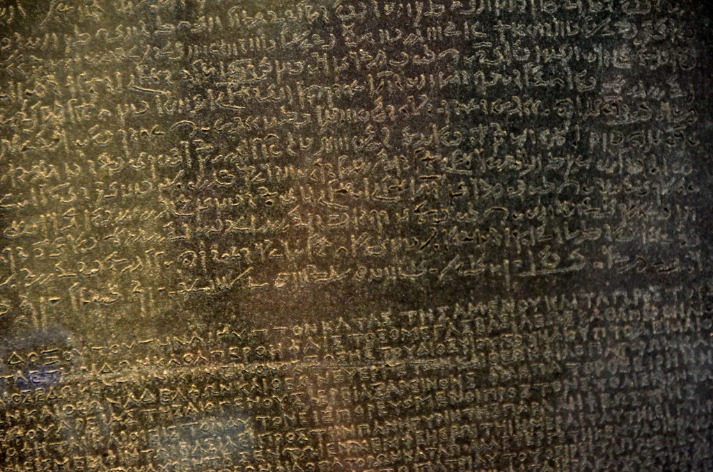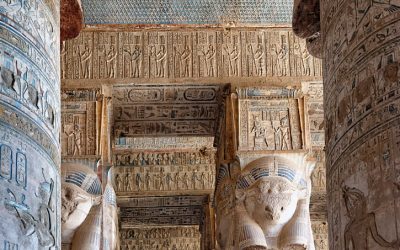Historical Background of Demotic Egypt
Demotic Egypt represents a significant phase in the long history of ancient Egyptian civilization, emerging around the late 7th century BCE and lasting until the 5th century CE. It evolved from earlier scripts such as hieratic and was used primarily by the common people for daily administrative, legal, and commercial documents. As a simplified writing system, Demotic played a vital role in the cultural and economic life of Egypt during a period marked by foreign influences, including Persian, Greek, and Roman rule, shaping the administrative landscape of ancient Egypt.
Origins and Development
Demotic Egypt refers to a significant phase in the history of ancient Egyptian writing and culture, marked by the widespread use of the Demotic script. This script emerged during the late Pharaonic period and became prominent in the Greco-Roman era, serving as a common script for administration, legal documents, and literature. Its origins trace back to earlier scripts such as Hieratic, which was adapted from hieroglyphs for more practical, everyday purposes. Over time, the Demotic script evolved to become more simplified and streamlined, facilitating rapid writing and easier literacy among the common people.
The development of Demotic was influenced by the need for a more efficient writing system as the administrative and commercial activities expanded. It first appeared in the Nile Delta region around the 7th century BCE, during the late Egyptian monarchies. As Egypt underwent various political and cultural changes, Demotic gained widespread usage, especially under Persian, Greek, and Roman rule. It was used extensively for personal correspondence, business transactions, and literary texts, reflecting its importance in daily life. By the 4th century CE, Demotic was gradually replaced by Coptic but remains a vital source for understanding the social, economic, and administrative history of ancient Egypt during this transformative period.
Timeline and Key Milestones
Demotic Egypt refers to the period and culture associated with the use of the Demotic script, a simplified form of the Egyptian writing system that evolved during the late Pharaonic period. It played a crucial role in everyday administration, literature, and legal documents from around the 7th century BCE until the 5th century CE. This script emerged during a time of significant political and social change, reflecting the shifting dynamics of Egyptian society under foreign influence and internal development.
The development of Demotic script is believed to have begun in the late 7th century BCE, during the Late Period of Egypt, following the decline of traditional hieratic script used for religious texts. It became more prominent during the 26th Dynasty (664–525 BCE), as it was increasingly utilized for administrative and commercial purposes. By the Ptolemaic Period (332–30 BCE), Demotic was the dominant script for daily affairs, literature, and legal documents, replacing earlier scripts in many contexts.
Key milestones in the history of Demotic Egypt include the first attestation of the script around 650 BCE, its formalization as a writing system for common use during the 7th century BCE, and its widespread adoption in both bureaucratic and literary texts by the 3rd century BCE. The script reached its peak during the Ptolemaic era, with extensive papyri and inscriptions documenting everyday life, contracts, religious texts, and scientific treatises.
Demotic’s decline began in the 1st to 4th centuries CE, as Greek and Latin influences grew with the Roman occupation of Egypt. Its usage gradually diminished, replaced by Coptic and Greek scripts. The last known Demotic inscriptions date to the early centuries of the Common Era, marking the end of its historical significance. Despite its decline, Demotic remains vital to Egyptology, providing valuable insights into the social, administrative, and literary history of ancient Egypt.
Influence of Political and Cultural Changes
Demotic Egypt represents a significant phase in the evolution of Egyptian written language, emerging around the late 7th century BCE during the Late Period. Its development was heavily influenced by the political and cultural shifts that occurred over centuries, particularly due to the conquests and administrative changes brought about by foreign rulers such as the Persians, Greeks, and Romans. As Egypt experienced these periods of foreign dominance, there was a need for a simplified script that could be widely used for daily administrative, legal, and commercial purposes, leading to the rise of Demotic as a more accessible and practical form of writing compared to hieroglyphs and hieratic.
The influence of political upheavals played a crucial role in shaping Demotic, as it was often adopted by various ruling powers to facilitate governance and communication across diverse populations. Culturally, the integration of Greek and later Roman elements further impacted the script’s evolution, with Demotic gradually losing prominence as other languages and scripts gained prominence under successive rulers. Despite this, Demotic remained an essential medium for everyday literacy and documentation for several centuries, reflecting the dynamic interplay between political authority, cultural identity, and linguistic development in Egypt’s rich history.
Characteristics of the Demotic Script
The Demotic script is a cursive writing system that was used in ancient Egypt for everyday purposes, evolving around the late seventh century BCE. Known for its speed and simplicity, it features a streamlined, flowing style that allowed for efficient writing on papyrus and other materials. As a highly practical script, Demotic incorporated both logographic and alphabetic elements, making it versatile for representing the Egyptian language in various contexts. Its characters are characterized by their sleek, connected form, reflecting the script’s functional role in administration, law, and literature throughout the Greco-Roman period of Egyptian history.
Script Features and Typology
The Demotic script was a simplified and highly adaptable form of writing used in ancient Egypt, primarily during the late period and into the Greco-Roman era. It served as the everyday script for administration, commercial activities, and literature, reflecting a shift from more formal hieroglyphic and hieratic scripts towards a more accessible writing system. Understanding its characteristics, features, and typology provides insight into its function and evolution in Egyptian history.
Characteristics of the Demotic Script include its cursive and flowing style, which allowed for quick handwriting on papyrus. It is characterized by its streamlined, simplified glyphs that evolved from hieratic signs, making it more practical for daily use. The script utilized a mixture of alphabetic, syllabic, and ideographic signs, demonstrating its versatility in representing the Egyptian language.
Script features of Demotic include its alphabet of around 30 signs, its consistent use of ligatures and abbreviations, and its notable cursiveness that facilitated rapid writing. The script often omits some of the more elaborate hieroglyphic details, favoring practicality and efficiency. It also incorporated a number of unique signs and conventions that distinguished it from both hieratic and hieroglyphic scripts.
In terms of typology, Demotic is classified as an alphabetic script with some syllabic and ideographic properties, representative of a mixed script type. It falls within the category of a cursive writing system, primarily used for everyday purposes rather than monumental inscriptions. Its linear, flowing form and adaptability made it ideal for scribes and administrators in a variety of contexts throughout Egyptian history.
Writing Materials and Tools
Demotic script, used in ancient Egypt from the late 7th century BCE to the 5th century CE, is characterized by its cursive and simplified form, making it efficient for daily writing and administrative purposes. It evolved from northern forms of hieratic writing and features a streamlined, flowing style with rounded and connected characters that facilitated quick scribbling. The script was primarily used for legal, business, and literary texts, reflecting its practicality and adaptability to various contexts.
Writing materials for Demotic script included papyrus, which was the most common medium, as well as ostraca (pottery shards) and wooden sticks for informal and temporary writings. The tools employed by scribes typically consisted of reed pens or brushes dipped in ink. The ink was made from carbon or soot mixed with a binder such as gum Arabic. These materials and tools allowed scribes to produce fluid, well-formed characters suited to the cursive nature of Demotic writing, enabling efficient communication across social and administrative spheres in ancient Egypt.
Distinctive Architectural and Manuscript Elements
The Demotic script, used in ancient Egypt, is characterized by its simplified and cursive form, making it more accessible and faster to write than earlier hieroglyphic or hieratic scripts. It evolved from northern forms of hieratic script around the 7th century BCE and was predominantly used for administrative, legal, and commercial documents. The script features streamlined characters with a swift, flowing style that often resembles shorthand, reflecting its practical application in daily life.
In terms of architectural elements, Demotic influence can be observed in the inscriptions and reliefs found on Egyptian monuments, papyri, and stelae. These inscriptions typically display a more informal and utilitarian aesthetic compared to the grandeur of hieroglyphic decorations. The script is often inscribed alongside hieroglyphs and hieratic, blending stylistic elements that emphasize clarity and conciseness rather than decorative complexity.
Manuscript elements characteristic of Demotic include papyrus documents that are usually narrow and rolled, with text frequently organized into columns. The ink used was often black, with occasional red for emphasis or headings. The script itself appears angular and connected, with characters sometimes exhibiting ligatures. These features facilitated quick writing, essential for the administrative and commercial functions that the Demotic script served in Egyptian society.
Demotic Language and Grammar
Demotic Egyptian is an ancient script that was used in Egypt from around 650 BCE to the 5th century CE. It evolved as a simplified form of the Egyptian script, making it more accessible for everyday use. The Demotic language played a crucial role in administrative, legal, and literary texts, reflecting the social and cultural life of ancient Egypt during its later periods. Understanding Demotic Grammar helps scholars unlock the history and society of this fascinating civilization.
Linguistic Features and Syntax
The Demotic language was a simplified form of ancient Egyptian script that emerged during the Hellenistic period in Egypt, approximately in the 7th century BCE. It served as a common written language for everyday administrative and literary purposes, distinct from the formal hieroglyphic and hieratic scripts. Demotic was used extensively in personal documents, legal texts, and literature, reflecting the evolving linguistic and cultural landscape of Egypt during this time.
Grammatically, Demotic retained core features from earlier Egyptian stages but simplified many of the grammatical structures. It primarily used a straightforward system of noun cases and verb forms, often relying on context rather than complex inflections. The language was characterized by its use of particles, prepositions, and a relatively limited set of verb conjugations, which made it more accessible for daily use compared to the highly formal hieroglyphic script.
The linguistic features of Demotic include a phonetic alphabet composed of simplified characters derived from both hieratic signs and demotic-specific symbols. Its vocabulary contained many words borrowed from Greek due to the Macedonian influence following Alexander the Great’s conquest. Phonologically, Demotic maintained Egyptian phonetic traits but showed signs of linguistic borrowing and innovation, particularly in the use of Greek loanwords.
In terms of syntax, Demotic primarily employed a subject-verb-object (SVO) order, although variations could occur depending on context or emphasis. Its sentence structures were generally straightforward, with an emphasis on clarity and efficiency. The language often used particles and auxiliary verbs to convey tense, mood, and aspect, making its syntax more flexible and easier to use in practical writing compared to the more complex structures of earlier Egyptian languages.
Vocabulary and Lexicon
Demotic Egyptian is an ancient script and language that was used in Egypt from around 650 BCE to the 5th century CE. It evolved from northern forms of hieratic writing and was employed primarily for administrative, legal, and commercial documents, making it a vital means of communication in daily Egyptian life during its period of use.
The grammar of Demotic shares many features with other Egyptian languages, including the use of noun cases, verb forms, and sentence structures typical of Semitic and Egyptian linguistic systems. It is a phonetic script, although some signs also serve ideographic or determinative purposes, reflecting the complexity of its grammatical structures.
In terms of vocabulary and lexicon, Demotic contains a mixture of native Egyptian words and loanwords from Greek and other languages, especially following the period of Greek influence after Alexander the Great’s conquest. The vocabulary was versatile, covering topics such as administration, religion, commerce, and everyday life, and it played a crucial role in the documentation of Egyptian culture and society during antiquity.
Comparison with Earlier Egyptian Languages
Demotic Egyptian is a script and language that developed during the late New Kingdom period and was widely used in Egypt from around the 7th century BCE until the 5th century CE. It represents a simplified, cursive form of earlier Egyptian scripts, primarily derived from northern forms of Hieratic, which itself evolved from the hieroglyphic system. Demotic served as a common script for everyday writing, including administrative documents, legal texts, and literary works, making it an essential part of a communicative evolution in Egyptian history.
Compared to earlier Egyptian languages, Demotic reflects a significant shift toward more streamlined and accessible writing. While hieroglyphs were highly pictorial and used mainly for religious and monumental inscriptions, the earlier Hieratic script was more cursive and used by priests for religious texts. Demotic further simplified these features, reducing the number of characters and adopting a more abstract and simplified style that was easier to write quickly. Linguistically, Demotic shows developments in grammar and vocabulary, incorporating elements from the late stages of the Egyptian language, and it exhibits influences from later languages such as Greek due to Egypt’s interactions with the Hellenistic world.
In comparison with Old and Middle Egyptian, the languages of earlier periods, Demotic represents a more colloquial and pragmatic stage of the language, used primarily for daily administration rather than formal monumental inscriptions. Grammatically, Demotic features a reduction in complex morphological forms seen in earlier Egyptian, favoring more straightforward syntactic structures. These changes highlight a linguistic evolution from the more formal and character-rich language of the hieroglyphic era to a more accessible mode of writing that supported the administrative and social needs of a changing Egypt.
Uses and Functions of Demotic Texts
Demotic texts in ancient Egypt played a vital role in everyday communication, administration, and literary expression. As a simplified script derived from northern forms of hieratic writing, demotic was widely used from the 7th century BCE until the 5th century CE. These texts provided insights into the social, economic, and cultural aspects of Demotic Egypt, serving functions that ranged from legal documents and commercial records to religious texts and personal correspondence. Understanding the uses and functions of demotic texts helps illuminate the pragmatic and administrative life of ancient Egyptian society during this period.
Administrative and Legal Documents
Demotic texts, integral to ancient Egyptian culture, served a variety of practical purposes, particularly in administration and law. These documents were primarily used for everyday writing, enabling officials and citizens to record transactions, agreements, and communications efficiently.
In administrative contexts, Demotic texts facilitated the management of resources, taxation, and commerce. They included records of payments, inventories, and official correspondence, streamlining bureaucratic processes in ancient Egypt.
Legal documents written in Demotic encompassed contracts, wills, and court records, ensuring legal matters were documented clearly and preserved for reference. These texts played a crucial role in enforcing laws, settling disputes, and defining property rights.
The use of Demotic in such documents reflects its significance as a practical, accessible script that supported the complex administrative and legal systems of late ancient Egypt. It allowed for the efficient handling of daily affairs, contributing to the stability and organization of Egyptian society.
Literary and Religious Texts
Demotic texts in ancient Egypt served a variety of uses and functions, reflecting the diverse needs of Egyptian society during the later periods of Egyptian history. These texts were primarily written in the demotic script, a simplified form of hieratic, and were used for everyday administrative, legal, and commercial purposes. As a practical script, demotic facilitated the recording of transactions, inventories, contracts, and official records, playing a crucial role in the management of economic and governmental affairs.
In addition to administrative applications, demotic texts also had significant literary functions. They include works of prose, poetry, and philosophical writings that aimed to entertain, educate, or preserve cultural knowledge among the population. These texts often addressed themes relevant to daily life, morality, and societal values, making literature more accessible to a broader audience beyond the scribes and elites.
Religious texts written in demotic also held vital functions, serving as personal and community tools for devotion and spiritual practice. Such texts included prayers, magical spells, and hymns that were used in personal rituals or communal ceremonies. The use of demotic in religious contexts allowed for greater dissemination of spiritual knowledge among the lay population, enabling them to participate more actively in religious life.
Overall, demotic texts in Egypt played an essential role in facilitating communication, preserving cultural practices, and supporting both secular and sacred aspects of Egyptian life. Their multifunctional nature underscores their importance as a bridge between the administrative, literary, and religious worlds of ancient Egypt.
Business Records and Personal Manuscripts
Demotic texts played a crucial role in ancient Egyptian society by serving various practical and administrative functions. These texts, written in the simplified Demotic script, facilitated the recording of everyday transactions, legal proceedings, and administrative details, making them accessible for a broader segment of the population. Business records, in particular, were essential for documenting commercial activities, trade agreements, tax assessments, and property transactions, ensuring organized economic management. Personal manuscripts provided insights into individual lives, including personal letters, literary compositions, and religious texts, reflecting the social and cultural facets of ancient Egypt. Overall, Demotic texts were vital for maintaining the administrative efficiency and personal communication of the time, bridging the gap between complex hieroglyphic inscriptions and the needs of ordinary people.
Archaeological Discoveries and Key Sites
Archaeological discoveries in Egypt have unveiled a rich tapestry of history, shedding light on ancient civilizations and their remarkable achievements. Key sites such as Thebes, Saqqara, and the Valley of the Kings offer invaluable insights into Egypt’s past, especially in understanding the demotic script used by common people during the later dynastic periods. These discoveries continue to deepen our appreciation of Egypt’s cultural heritage and the everyday lives of its ancient inhabitants.
Major Find Locations
Demotic Egypt represents a fascinating period in ancient Egyptian history, characterized by the use of the Demotic script and a flourishing of cultural and administrative activities. Key archaeological discoveries from this era have shed light on the daily life, governance, and literary practices of the time. Prominent sites such as the Temple of Kom Ombo and the tombs in the Theban Necropolis have yielded valuable artifacts inscribed in Demotic, offering insights into societal organization and religious beliefs.
Major find locations include the ruins of the city of Panopolis (modern Aqaba), which was an important administrative center during the Greek and Roman periods in Egypt, featuring inscriptions and papyri in Demotic script. The Demotic Papyrus of the Elephantine Papyri collection, discovered in southern Egypt, provides extensive documentation of legal, commercial, and personal documents from the 4th century BCE. Additionally, the site of Tebtunis is notable for its extensive papyri and inscriptions that illuminate Demotic writing’s role in mundane and religious contexts.
Notable Artifacts and Manuscripts
Demotic Egypt, an important phase in ancient Egyptian history, is renowned for its vibrant archaeological discoveries and key sites that have unveiled extensive insights into everyday life and administrative practices. Notable locations such as the Nile Delta cities of Sebennytos and Philae have yielded significant artifacts, shedding light on the cultural and religious developments during the late pharaonic and Ptolemaic periods.

Among the most remarkable artifacts are inscriptions and papyri written in the demotic script, which was used primarily for secular literature, legal documents, and administrative records. These manuscripts have proven invaluable for understanding the social structures, economy, and daily activities of common people in ancient Egypt. Noteworthy discoveries include the Rosetta Stone, which facilitated the decipherment of hieroglyphs but also contains demotic script, and the Chester Beatty Papyri, a collection of texts providing insights into magical practices, medical prescriptions, and personal correspondence.
The study of demotic manuscripts continues to be a crucial area of archaeological research, helping scholars piece together the nuanced history of Egypt during the late periods. Key sites like the Temple of Philae and the cemeteries at Saqqara have revealed extensive demotic texts, emphasizing the script’s role in administrative and religious contexts. These discoveries not only illuminate the linguistic evolution of Egyptian scripts but also offer a glimpse into the social and cultural environment of the ancient Egyptian civilization.
Significance of Discoveries for Understanding Demotic Egypt
Archaeological discoveries and key sites play a crucial role in shedding light on Demotic Egypt, a period marked by the use of the Demotic script and language that flourished from around 7th century BCE to the 5th century CE. Sites such as the Napatan and Philae temples, as well as the famous papyri found in the Tebtunis archives, have provided invaluable insights into the social, cultural, and administrative aspects of Demotic Egypt. These discoveries help researchers understand the daily life, legal systems, and religious practices of the time, offering a comprehensive picture of a society that experienced significant transitions under Hellenistic and Roman rule.
The significance of these archaeological finds lies in their ability to decode the Demotic script, which was a simplified form of writing used for everyday purposes. The texts uncovered at key sites have helped linguists and historians interpret inscriptions, bureaucratic documents, literary texts, and religious writings, thereby deepening knowledge about language development and cultural continuity. Additionally, these discoveries illuminate the interactions between native Egyptian traditions and foreign influences, contributing to a broader understanding of Egypt’s historical landscape during this era. Overall, archaeological findings are vital in reconstructing the history of Demotic Egypt and appreciating its role within the broader framework of ancient Egyptian civilization.
Decline and Transition to Other Scripts
The decline of Demotic Egyptian script marked a significant transition in the history of written language in ancient Egypt. As cultural and political changes occurred, Demotic gradually fell out of use, giving way to new scripts that reflected evolving societal needs. This transition highlights the dynamic nature of written communication and the shifts in literacy practices over time, providing valuable insight into the history of Egypt’s linguistic landscape.
Factors Leading to the Decline of Demotic
The decline of Demotic in Egypt was influenced by several historical and cultural factors that contributed to its transition into other scripts and languages. As a primarily popular script used by the common people for administrative and literary purposes, Demotic gradually lost prominence with the changing political and social landscape of Egypt.
One major factor leading to the decline of Demotic was the increasing dominance of Greek following the conquest of Egypt by Alexander the Great and the subsequent Hellenistic influence. Greek became the official language of administration and scholarship, relegating Demotic to a more peripheral role. This shift diminished the practical utility of Demotic in official contexts and contributed to its gradual abandonment.
Additionally, the rise of Coptic, which evolved from the late Demotic script and incorporated the Greek alphabet with some Demotic signs, played a significant role in the transition. Coptic became the liturgical language of Christianity in Egypt, further reducing the use of Demotic in daily and administrative life. As religious and cultural practices changed, so did the scripts used for communication.
The decline of native Egyptian scripts like Demotic was also driven by the broader process of linguistic and cultural assimilation into the Hellenistic and Roman worlds. The increased influence of Greek and later Latin, coupled with the decline of Egyptian autonomy, led to reduced usage of Demotic in favor of these more dominant languages and scripts.
Overall, the decline of Demotic was due to a combination of political conquest, cultural shifts towards Hellenism and Christianity, and the natural evolution of writing systems that adapted to the changing societal needs and languages in Egypt.
Transition to Coptic and Egyptian Scripts
The decline of the Demotic script marked a significant transition in the linguistic history of Egypt, leading to the adoption of other scripts such as Coptic and continued use of Egyptian scripts in different contexts. As Demotic gradually fell out of everyday use, especially after the Roman period, Coptic emerged as the primary script for Egyptian language, blending the ancient Egyptian script with the Greek alphabet. This shift facilitated the preservation of the language in religious and literary contexts, ensuring its continuity beyond the decline of Demotic. The transition reflects broader socio-cultural changes, including the influence of Hellenistic culture and Christianity, which favored the use of Coptic for religious texts. Over time, the use of Demotic diminished, but its legacy persisted through the Coptic script, which served as a vital link to Egypt’s ancient past while adapting to new religious and cultural realities.
Historical Impact of Script Transition
The decline of Demotic script and its transition to other writing systems marked a significant turning point in Egyptian history, reflecting broader social, cultural, and political changes. As Greek and later Coptic scripts gained prominence, Demotic, which had served as a practical script for everyday administrative and literary purposes, gradually diminished in use. This transition was driven by the increasing influence of foreign cultures and the integration of Egypt into the Hellenistic world, leading to the replacement of traditional scripts with those better suited to new administrative, religious, and cultural needs.
The shift from Demotic to Greek and Latin scripts significantly impacted the transmission of knowledge, administrative practices, and cultural identity within Egypt. The decline of Demotic coincided with the rise of Christianity and the subsequent adoption of Coptic, which preserved demotic vocabulary and concepts within a new script system. This transformation facilitated the spread of Christian literature and religious texts, shaping Egypt’s spiritual and cultural landscape for centuries.
Historically, the transition of scripts reflects the broader process of cultural adaptation and resilience, illustrating how Egyptians navigated their changing political landscape while balancing preservation of their heritage with external influences. The decline of Demotic also contributed to the eventual erosion of native literacy for a period, yet it laid the groundwork for the development of Coptic as a literary language. Overall, the transition of scripts in Egypt exemplifies how writing systems evolve over time in response to internal and external pressures, leaving a lasting legacy for historical and linguistic studies.





0 Comments